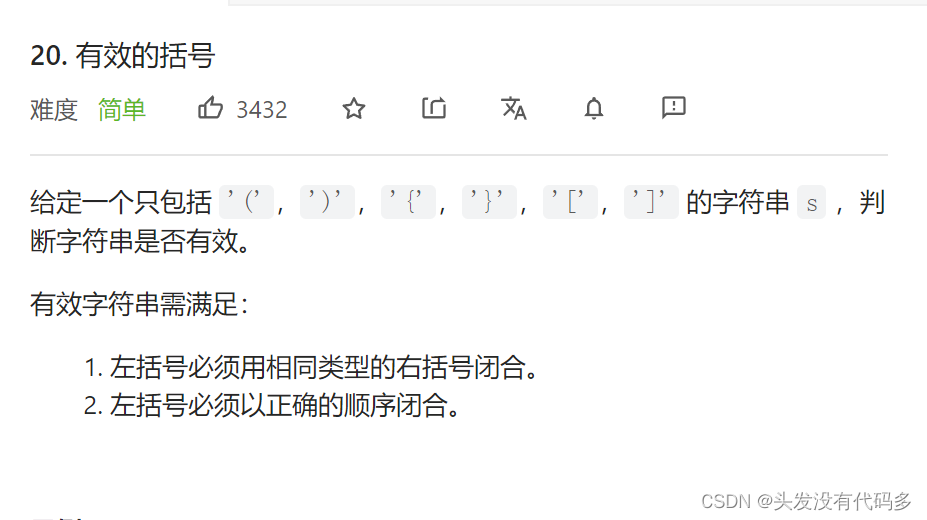-
数据结构——栈和队列
目录
栈
栈:一种特殊的线性表,其只允许在固定的一端进行插入和删除元素操作。进行数据插入和删除操作的一端称为栈顶,另一端称为栈底。栈中的数据元素遵守后进先出LIFO(Last In First Out)的原则。栈向下增长
压栈:栈的插入操作叫做进栈/压栈/入栈,入数据在栈顶。
出栈:栈的删除操作叫做出栈。出数据也在栈顶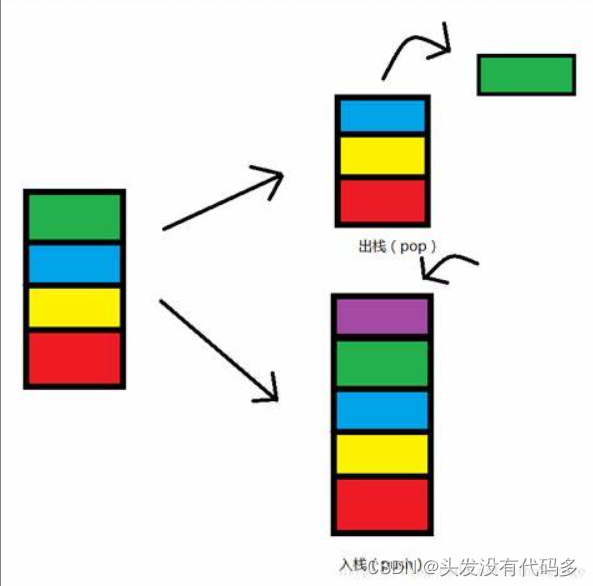
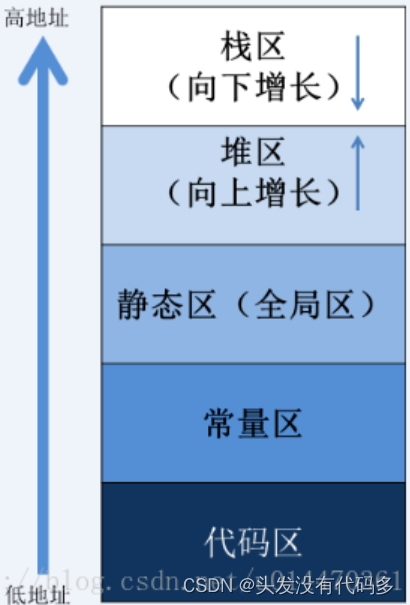
动态开辟在堆区,堆向上增长,递归次数过多会导致栈溢出
栈的实现一般可以使用数组或者链表实现,相对而言数组的结构实现更优一些。因为数组在尾上插入数据的代价比较小。
习题
1.一个栈的初始状态为空。现将元素1、2、3、4、5、A、B、C、D、E依次入栈,然后再依次出栈,则元素出
栈的顺序是( )。
A 12345ABCDE
B EDCBA54321
C ABCDE12345
D 54321EDCBAB 先进后出
2.若进栈序列为 1,2,3,4 ,进栈过程中可以出栈,则下列不可能的一个出栈序列是()
A 1,4,3,2
B 2,3,4,1
C 3,1,4,2
D 3,4,2,1
C A1先入,再出1,然后入2,3,4,出4,3,2B先入1,2出2,入3,出3,入4,出4,出1
D入1,2,3出3,入4,出4,出2,出1
结构体的创建
- typedef int STDdtaTtype;
- typedef struct Stcak
- {
- STDdtaTtype* data;
- int top;
- int capacity;
- }ST;
初始化
- void StackInit(ST* ps)
- {
- assert(ps);
- ps->data = NULL;
- ps->capacity = ps->top = 0;
- }
销毁开辟空间
- void StackDestory(ST* ps)
- {
- assert(ps);
- free(ps->data);
- ps->capacity = ps->top = 0;
- ps->data = NULL;
- }
入栈
- void StackPush(ST* ps, STDdtaTtype x)//注意要看top的位置是0还是-1
- {
- assert(ps);
- int newcapacity = ps->capacity == 0 ? 4 : ps->capacity * 2;
- if (ps->capacity == ps->top)//判断是否满了
- {
- STDdtaTtype* tmp = realloc(ps->data, sizeof(ps) * newcapacity);
- if (tmp == NULL)
- {
- perror("realloc fail");
- exit(-1);
- }
- ps->data = tmp;
- ps->capacity = newcapacity;
- }
- ps->data[ps->top] = x;
- ps->top++;
- }
出栈
- void StackPop(ST* ps)
- {
- assert(ps);
- assert(!StackEmpty(ps));
- --ps->top;
- }
当前栈顶
- STDdtaTtype StackTop(ST* ps)
- {
- assert(ps);
- assert(!StackEmpty(ps));
- return ps->data[ps->top - 1];
- }
判断栈是否为空
- bool StackEmpty(ST* ps)//判断是否为空栈
- {
- assert(ps);
- return ps->top == 0;
- }
统计个数
- int StackSize(ST* ps)
- {
- assert(ps);
- return ps->top;
- }
力扣习题——有效的括号
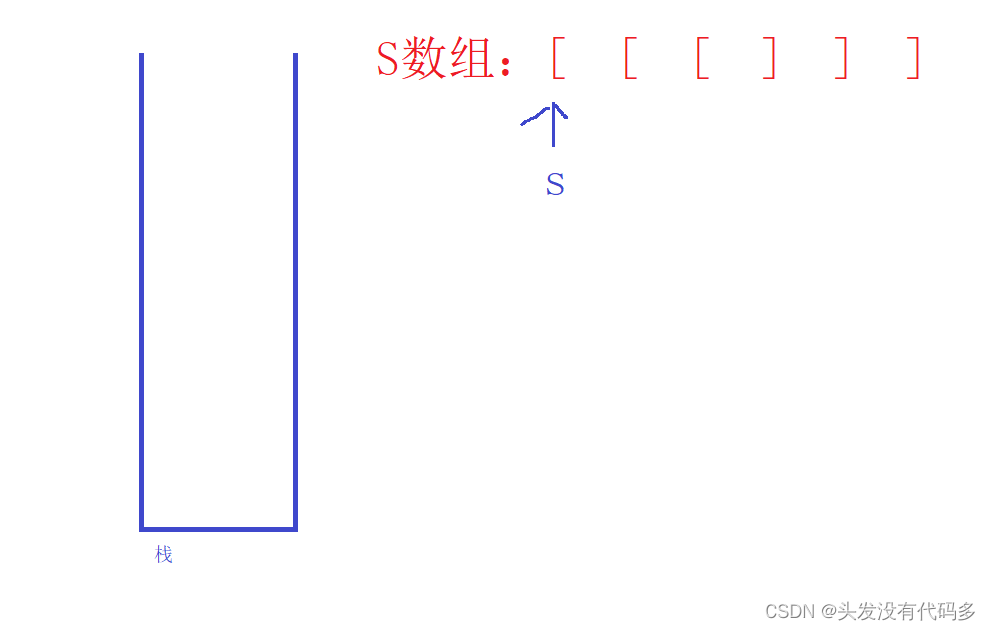
当s指向左括号时,把该括号放入栈内
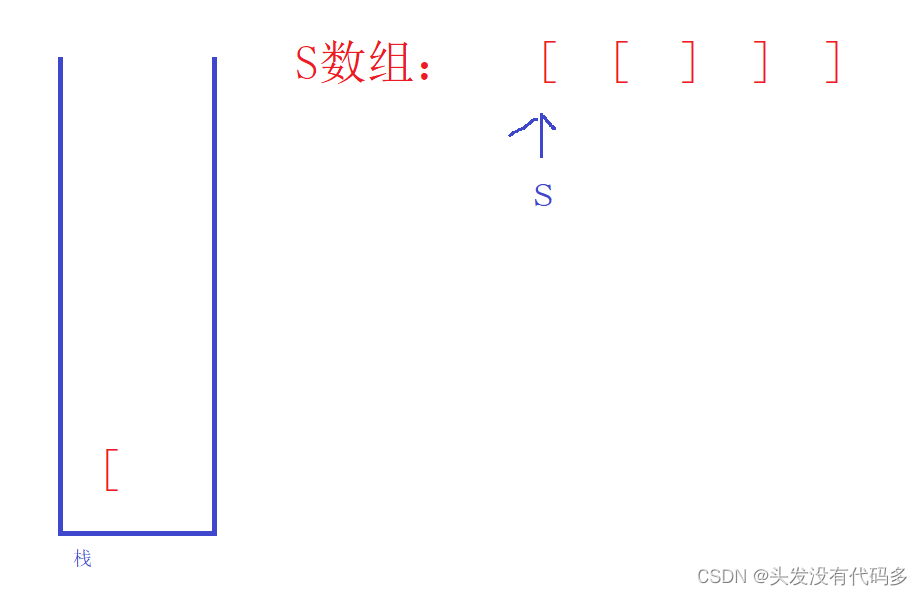
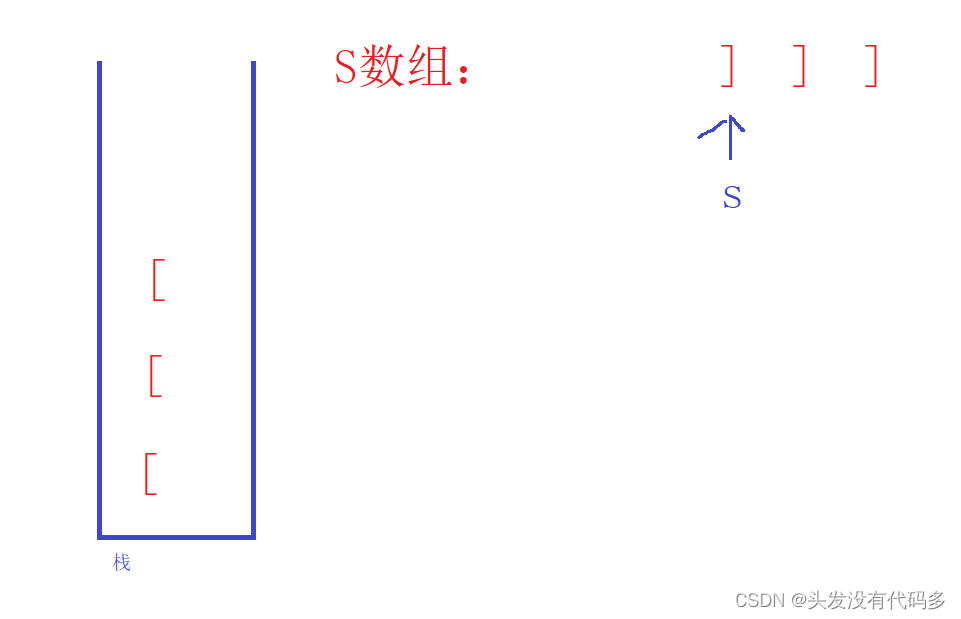
入完栈之后s不等于左括号,s等于右括号,然后将栈内的元素一个个拿出来跟s所指括号比较,若能匹配成功,则进行下一轮比较,反之则直接返回false
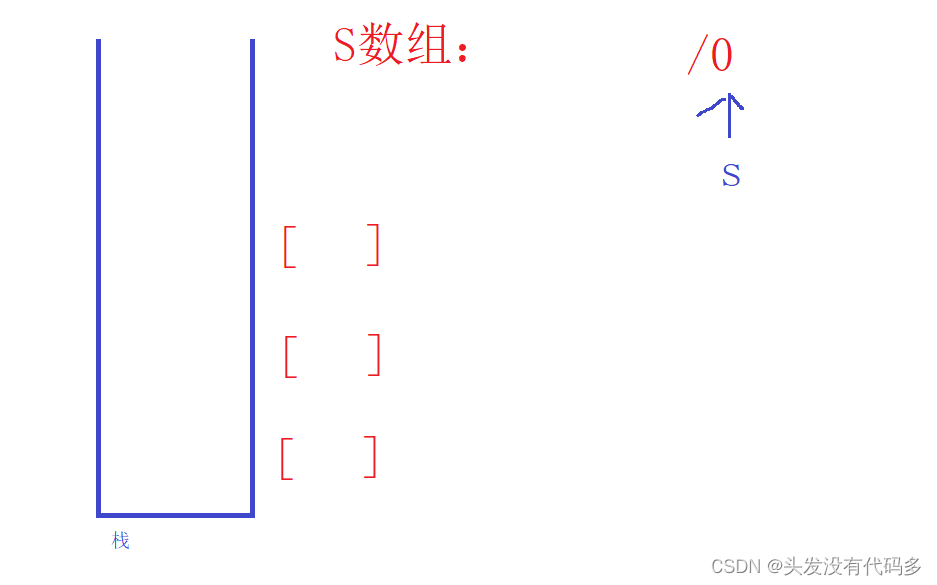
- typedef char STDdtaTtype;
- typedef struct Stcak
- {
- STDdtaTtype* data;
- int top;
- int capacity;
- }ST;
- void StackInit(ST* ps);
- void StackDestory(ST* ps);
- void StackPush(ST* ps, STDdtaTtype x);
- void StackPop(ST* ps);
- bool StackEmpty(ST* ps);
- int StackSize(ST* ps);
- STDdtaTtype StackTop(ST* ps);
- void StackInit(ST* ps)
- {
- assert(ps);
- ps->data = NULL;
- ps->capacity = ps->top = 0;
- }
- void StackDestory(ST* ps)
- {
- assert(ps);
- free(ps->data);
- ps->capacity = ps->top = 0;
- ps->data = NULL;
- }
- void StackPush(ST* ps, STDdtaTtype x)//注意要看top的位置是0还是-1
- {
- assert(ps);
- int newcapacity = ps->capacity == 0 ? 4 : ps->capacity * 2;
- if (ps->capacity == ps->top)//判断是否满了
- {
- STDdtaTtype* tmp = realloc(ps->data, sizeof(ps) * newcapacity);
- if (tmp == NULL)
- {
- perror("realloc fail");
- exit(-1);
- }
- ps->data = tmp;
- ps->capacity = newcapacity;
- }
- ps->data[ps->top] = x;
- ps->top++;
- }
- void StackPop(ST* ps)
- {
- assert(ps);
- assert(!StackEmpty(ps));
- --ps->top;
- }
- STDdtaTtype StackTop(ST* ps)
- {
- assert(ps);
- assert(!StackEmpty(ps));
- return ps->data[ps->top - 1];
- }
- bool StackEmpty(ST* ps)//判断是否为空栈
- {
- assert(ps);
- return ps->top == 0;
- }
- int StackSize(ST* ps)
- {
- assert(ps);
- return ps->top;
- }
把上面栈的函数都复制下来,进行括号匹配
- bool isValid(char * s){
- ST st;
- StackInit(&st);
- while(*s)
- {
- if(*s=='['||*s=='{'||*s=='(')
- {
- StackPush(&st,*s);
- }
- else
- {
- if(StackEmpty(&st))//若栈内为空,直接返回false,这种情况如只S数组只有一个[
- {
- StackDestory(&st);//防止内存泄漏
- return false;
- }
- STDdtaTtype top=StackTop(&st);
- StackPop(&st);
- if(*s==']'&&top!='['
- ||*s=='}'&&top!='{'
- ||*s==')'&&top!='(')
- {
- return false;
- }
- }
- s++;
- }
- bool flag=(StackEmpty(&st));//若全部匹配则,栈内为空,若没有则不为空
- StackDestory(&st);
- return flag;
- }
队列
队列:只允许在一端进行插入数据操作,在另一端进行删除数据操作的特殊线性表,队列具有先进先出
FIFO(First In First Out) 入队列:进行插入操作的一端称为队尾 出队列:进行删除操作的一端称为队头,一般用单链表实现队列,双向链表比较浪费
结构体的建立
- typedef int QDataType;
- typedef struct QueueNode
- {
- struct QueueNode* next;
- QDataType data;
- }QNode;
- typedef struct Queue
- {
- QNode* head;
- QNode* tail;
- size_t size;
- }Queue;
初始化
- void QueueInit(Queue* pq)
- {
- assert(pq);
- pq->head = pq->tail = NULL;
- pq->size = 0;
- }
动态内存销毁
- void QueueDestory(Queue* pq)
- {
- assert(pq);
- QNode* cur = pq->head;
- while (cur)
- {
- QNode* del = cur;
- cur = cur->next;
- free(del);
- del = NULL;
- }
- pq->head = pq->tail = NULL;
- }
入队
- void QueuePush(Queue* pq, QDataType x)
- {
- assert(pq);
- QNode* newnode = (QNode*)malloc(sizeof(QNode));
- assert(newnode);
- newnode->data = x;
- newnode->next = NULL;
- if (pq->tail == NULL)
- {
- pq->head = pq->tail = newnode;
- }
- else
- {
- pq->tail->next = newnode;
- pq->tail = pq->tail->next;
- }
- pq->size++;
- }
出队
- void QueuePop(Queue* pq)
- {
- assert(pq);
- assert(!QueueEmpty(pq));
- if (pq->head->next == NULL)
- {
- free(pq->head);
- pq->head = pq->tail = NULL;
- }//如果只剩一个节点,单独处理,要不染当head遍历到tail时候,tail会成为野指针,这里要防止tail变为野指针
- else
- {
- QNode* cur = pq->head;
- pq->head = pq->head->next;
- free(cur);
- cur = NULL;
- }
- pq->size--;
- }
提取数据
- QDataType QueueFront(Queue* pq)//取头数据
- {
- assert(pq);
- assert(!QueueEmpty(pq));
- return pq->head->data;
- }
- QDataType QueueBack(Queue* pq)//取尾数据
- {
- assert(pq);
- assert(!QueueEmpty(pq));
- return pq->tail->data;
- }
判断是否为空
- bool QueueEmpty(Queue* pq)
- {
- assert(pq);
- return pq->head==NULL && pq->tail==NULL;
- }
队内元素个数统计
- int QueueSize(Queue* pq)
- {
- return pq->size;
- }
-
相关阅读:
限时免费领《新程序员》电子书啦!
计算机操作系统 第六章:输入输出系统(3)
[NSSRound#7 Team]ShadowFlag
java之线程间通信
.NET delegate 委托 、 Event 事件,接口回调
【鸿蒙最新全套教程】<HarmonyOS第一课>1、运行Hello World
【html】H2_列表、表格与媒体元素
浅谈中国汽车充电桩行业市场状况及充电桩选型的介绍
VulnHub1:Jangow: 1.0.1靶机学习
便携式电能质量分析仪
- 原文地址:https://blog.csdn.net/weixin_49449676/article/details/126160953

